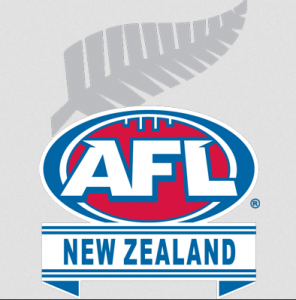 For this installment in the International footy series, I talked to Rob Vanstom, the CEO of AFL NZ, with additional information supplied by Alex Braae, the media co-ordinator.
For this installment in the International footy series, I talked to Rob Vanstom, the CEO of AFL NZ, with additional information supplied by Alex Braae, the media co-ordinator.
New Zealand is one of our closest neighbors and indeed was considered to be part of the Australasian football community until the advent of World War 1 when the game all but disappeared across the Tasman. In recent times it has become the mission of the NZ AFL (now AFL NZ) to develop the game of Australian football.
Rob Vanstom is the Cheif Executive Offficer of the AFL NZ. He’d been living in New Zealand for five years before becoming aware of the games presence in the country,. He started out coaching the North Shore Tigers in Auckland before taking on the New Zealand national senior side.
There are currently five Australian Football Leagues in New Zealand, the most recent addition being Otago, with leagues also based in Auckland, Canterbury, Waikito, and Wellington. Each year, the leagues send a representative team to the Natioanl Provincial Championships. Held in October last year, the NPC’s were won for the third time in a row by the Canterbury side who went through the competition last year undefeated. The 2013 championships will be held in christchurch next week.
The Auckland league premiership was taken out this year by the Waitakere Magpies, who defeated Mt Roskill 76-65. The AAFL features six senior clubs – Manurewa ,Mt.Roskill, North Shore, Pakuranga ,University and Waitakere
Rob says that there are 30,000 participants in Australian football programs in New Zealand. Of these 95% are based in Kiwikick – the New Zealand variety of Auskick. Expatriate Australians would make up less than 2% of the total.
Since 2009, the Hawthorn football club has sponsored the “Hawks Cup”, inter school competition in New Zealand. Australian football was fomally sanctioned by the New Zealand Secondary School Sports Council in 2009 and in 2010 was introduced into seventy schools. Since then it has come along in leaps and bounds.
Matches are played on either an Oval or rectangle depending on availability with team sizes ranging from 18 a side in the senior leagues to 9 or 6 a side. Rob tells me that the key to success is being able to modify the game to suit its surroundings.
Australian football recieves an important media boost that is unavailable elsewhere by having extensive free to air coverage – 6 games live, and 3 on delay – on Sommet Sports (freeview channel 14 – they are showing classic afl matches at the moment).
New Zealand came third (for the second time) at the last International Cup, having won the competition in 2005. and are generally regarded as one of the “big 3” of international australian footy. New Zealand are ranked quite highly overall with a win rate of 87% putting it over every other side to compete so far.
Other strong teams in the mens division remain Ireland and Papua New Guinea – Rob says that they have some considerable advantages – New Guinea with its pathway into Queensland football, and Ireland with its strong Gaelic football community.
Rob says that the International Cup will see the debut of a New Zealand womens team (The Kahus) in a major boost for international womens competition.
In 2013 the AFL played its first game for premiership points outside of Australia at Wellington in New Zealand. The game was attended by more than 22,000 people, with hotels in the area sold out, and the Wellington council assured of its economic benefit (estimated at about 8.5 million for the day). A deal for St Kilda to play there on Anzac Day for a further five years was finalised in September.
The AFL stages a draft combine in New Zealand which has resulted in a number of players being taken by Hawthorn, with Shem Tatapu and Kurt Heatherly being named to the rookie list in 2013. Other players are on the International Scholarship list for St Kilda and Hawthorn.
Heatherly is an interesting story in his own right. From Waikito, at fourteen he became the first international scholarship player to be signed by Hawthorn. His uncle is Geoff Hines, who played 12 games of rugby union as an All Black for New Zealand.
AFL New Zealand recently announced its New Zealand Heritage team, a team of current AFL players who could represent New Zealand under similar rules to that used by Rugby League for the 2013 World Cup. These included: Beau Maister, Sam Mitchell, Shane Savage, Dustin Martin, Simon Black, Nathan Van Berlo, Paul Bower, Jordan Russell, Greg Broughton, Max Gawn, Aaron Edwards, Brent Renouf, and Heath Grundy – amongst others.
Rob says that it would be nice to see a New Zealand Heritage side line up against a side like the Aboriginal All Stars for instance. And with no round ball!
Rob also mentions that there are 700,000 New Zealanders living in Australia. He says that there are some sides that have quite a few NZ guys in the side – citing the NT Thunder as having at least five players originating in New Zealand. Who knows how many more there are out there that could represent New Zealand?
If you would like to get involved in footy in New Zealand, please visit the website at www.aflnz.co.nz. or email playafl@aflnz.co.nz
Please note that no audio is available for this interview. You can continue the discussion here.



